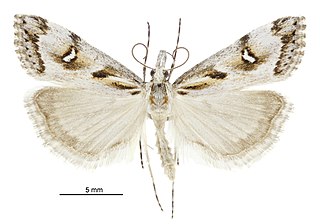
Lichenaula tuberculata is a moth of the family Xyloryctidae. It is endemic to Australia, more specifically the Australian Capital Territory and New South Wales.

Gadira leucophthalma, the beaked moss moth, is a moth in the family Crambidae. It is endemic to New Zealand. It is found in the south eastern side of the South Island down to Banks Peninsula. G. leucophthalma inhabits the foredunes of coastal areas. The larval host is unknown but it has been hypothesised that the larvae feed on moss. The adult moths are day flying although some specimens have been trapped at night via light traps. Adults are commonly on the wing from March to April. This species has been classified as Nationally Vulnerable by the Department of Conservation.
Metasia aphrarcha is a moth in the family Crambidae. It was described by Edward Meyrick in 1887. It is found in Australia, where it has been recorded from Western Australia.
Pycnarmon macrotis is a moth in the family Crambidae. It was described by Edward Meyrick in 1897. It is found in the Talaut Islands of Indonesia.
Garrha carnea is a moth in the family Oecophoridae. It was described by Philipp Christoph Zeller in 1855. It is found in Australia, where it has been recorded from Queensland, New South Wales, Victoria, Tasmania and South Australia.
Stenoma scoliandra is a moth of the family Depressariidae. It is found in Brazil, French Guiana and Guyana.
Antaeotricha ptycta is a species of moth of the family Depressariidae. It is found in Guatemala, Panama, Ecuador, the West Indies and Guyana.
Cerconota censoria is a moth of the family Depressariidae. It is found in Guyana.
Cerconota impressella is a moth of the family Depressariidae. It is found in Brazil (Para), Peru, and the Guianas.
Dinotropa ochrocrossa is a moth of the family Depressariidae and the only species in the genus Dinotropa. It is found in French Guiana.
Stenoma stupefacta is a moth of the family Depressariidae. It is found in French Guiana.
Antaeotricha phollicodes is a moth of the family Depressariidae. It is found in French Guiana.
Antaeotricha bicolor is a species of moth of the family Depressariidae. It is found in Brazil.
Comocritis nephelista is a moth in the family Xyloryctidae. It was described by Edward Meyrick in 1914. It is found in Sri Lanka.
Lichenaula musica is a moth in the family Xyloryctidae. It was described by Edward Meyrick in 1890. It is found in Australia, where it has been recorded from South Australia, Victoria and Western Australia.
Xylorycta melanula is a moth in the family Xyloryctidae. It was described by Edward Meyrick in 1890. It is found in Australia, where it has been recorded from New South Wales.
Eclecta is a monotypic moth genus in the family Depressariidae. Its only species, Eclecta aurorella, has been found in the Australian state of New South Wales. Both the genus and species were first described by Edward Meyrick in 1883.
Coptotelia nigriplaga is a moth in the family Depressariidae. It was described by Paul Dognin in 1904. It is found in Colombia and Ecuador.
Agriophara cinerosa is a moth in the family Depressariidae. It was described by Rudolph Rosenstock in 1885. It is found in Australia, where it has been recorded from Queensland, New South Wales, Victoria and South Australia.
Antaeotricha teleosema is a moth in the family Depressariidae. It was described by Edward Meyrick in 1925. It is found in Brazil.

